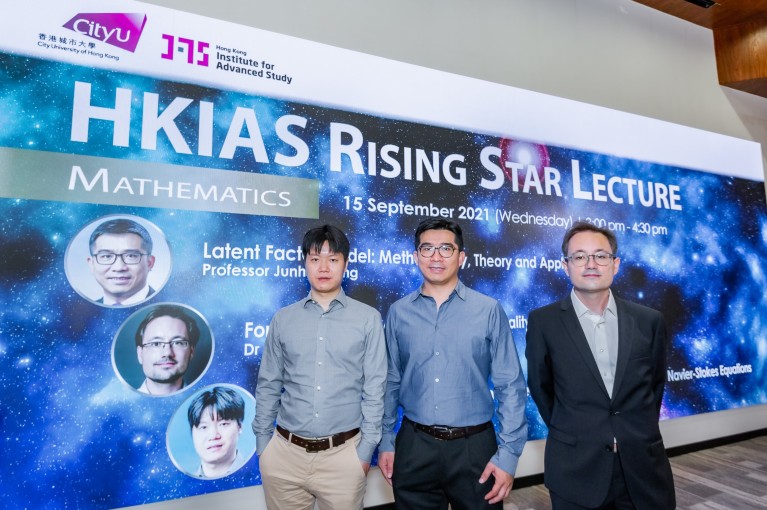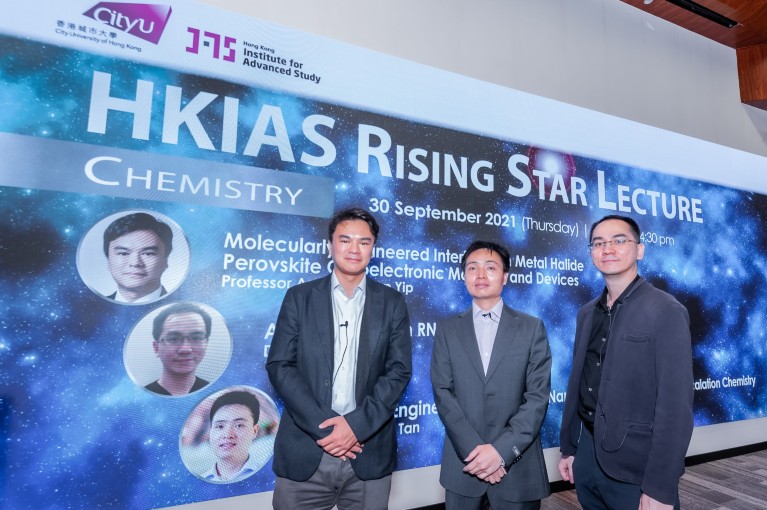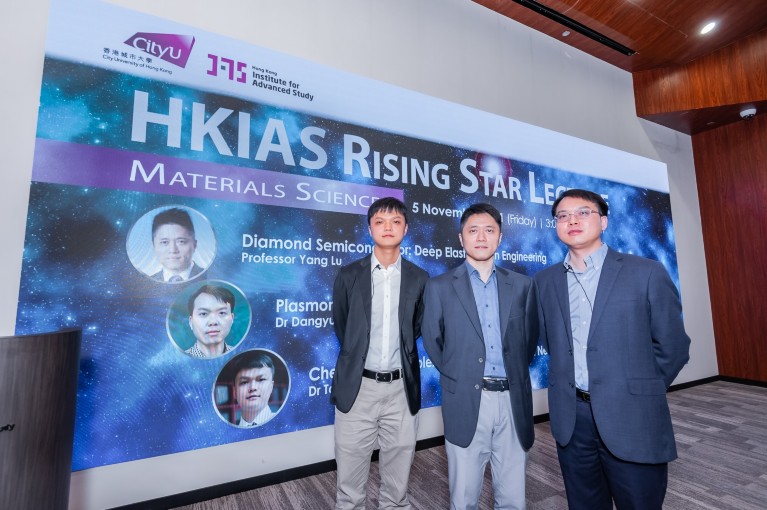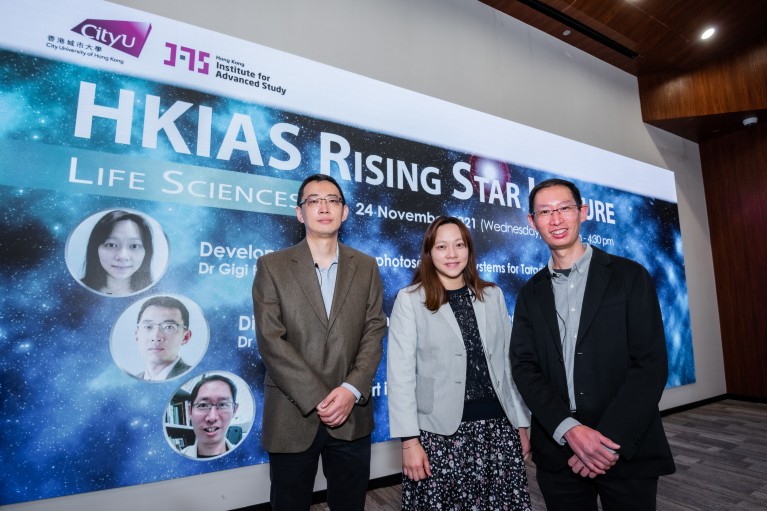A growing body of research by some of the most promising CityU early-career researchers at the intersection of fast-developing fields in fundamental science was presented at the 2021 Hong Kong Institute for Advanced Study (HKIAS) Rising Star Lecture Series.
The lecture series, which champions cross-disciplinary ideas and their real-world potential, was held both in person and virtually from 15 September to 24 November 2021. The lecture series covered five major subjects in mathematics, chemistry, physics, materials science, and life sciences and featured 15 short-listed scholars who went through a rigorous selection process.
“Nurturing new talent with a rewarding career has been a major mission of HKIAS since our establishment in 2015,” said HKIAS executive director, Jacob C. Huang. “This time, we wanted to celebrate the accomplishments and potential of researchers at the early stages of their independent careers.”
Huang explained that the goal of the lecture series is to promote diversity in academia, and to draw international attention to the latest work from the next generation of academic leaders. Following their research presentation and interactive exchange, the speakers were awarded substantial research grants to conduct their research projects at CityU.
“Our lecture series attracted a large audience and received great enthusiasm from our community, and many expressed their wish to join as speakers,” he said.
Navigating complexities with mathematical models
Xianpeng Hu, Junhui Wang and Pierre Nolin (From left to right)Credit: HKIAS
The first three lectures in the series were presented on 15 September 2021 by three young CityU mathematicians who discussed their work on latent factor modelling, mapping dynamical systems, and partial differential equations.
A latent factor model relates a set of observable variables to evaluate causality. Junhui Wang, a specialist in statistical machine learning, outlined mathematical frameworks to improve the analytical predictability and accuracy of relational data. This could enhance recommender system, network embedding, as well as work on biological and social networks.
A long-time investigator in statistical mechanics, Pierre Nolin, introduced advances in data simulation for two mathematical models that map dynamical systems. A model for excitable media, forest-fire models describe systems that display self-organized criticality, whereby any external force could trigger changes in the system's internal energy. Nolin also shared his insights on a related model for random media, Bernoulli percolation, which describes network behaviour following the addition of new nodes or links of causality.
Also playing an important role in modelling real-world phenomena are generalized solutions, also known as weak solutions. The lecture ended with insights from an expert in partial differential equations, Xianpeng Hu, who shared his approaches towards compressible Navier-Stokes Equations, which describe the motion of viscous fluid substances in computational fluid dynamics.
Understanding biological and structural chemistry
Angus Hin Lap Yip, Chaoliang Tan and Chun Kit Kwok (From left to right)Credit: HKIAS
The second lecture, on chemical science, featured new findings in interface chemistry, biological chemistry, and intercalation chemistry, that extend to optoelectronic devices, biological systems, and material engineering.
Materials scientist, Angus Hin Lap Yip, has been studying optoelectronic materials and devices to generate and save energy through next-generation solar cells and lighting technologies. He summarized his recent findings in molecularly engineered interfacial and perovskite materials, including the control of the dimension and nanostructure of optoelectronic materials.
A joint founder of the Hong Kong RNA Club, Chun Kit Kwok, shed light on a particular motif of the RNA structure known as RNA G-quadruplex (rG4), a promising target for cancer therapy, and demonstrated the early potential of a new class of rG4 targeting tool for manipulating rG4-protein interactions and rG4-mediated gene expressions.
Chaoliang Tan presented his recent research on structural engineering, including layer coupling, phase, defect and interlayer spacing of layered nanomaterials by lithiation intercalation chemistry, providing a strategy to activate or optimize their performance in photothermal cancer therapy and aqueous Zn-ion battery.
Mobilizing new forces in physics
Qi Liu, Cheng Wang and Danfeng Li (From left to right)Credit: HKIAS
A field in the spotlight for physicists is the study of condensed matter. From the macroscopic to microscopic level, developments in the understanding of physical properties in the superconducting phase could enable major breakthroughs.
Part of a team who discovered the first nickelate superconductor in 2019, Danfeng Li began the lecture with a glimpse of his team’s attempts to achieve superconductivity in reaction conditions similar to those occurring in biological systems, or a soft chemistry approach. He set his sights on infinite-layer nickelates for a potential class of superconductors that hold the promise of zero electrical resistance in high-performance electric power transmission.
In more than 30 years since its discovery, lithium cobalt oxide (LiCoO2) has dominated the cathode technology of Li-ion batteries for smartphones. Simply cycling LiCoO2 at a higher voltage can boost capacity, but causes significant structural instability. Its commercial exploration has progressed slowly, with a maximum capacity averaging 40% less than its theoretical threshold. Qi Liu explained how his team pushed the cut-off voltage of LiCoO2 to 4.5V via lanthanum and aluminium doping.
To conclude, microelectronics engineering specialist Cheng Wang shared his recent progress in enhancing light-matter interaction in nanophotonic structures, such as integrated lithium niobate photonic circuits for optical communications and nonlinear optics, a broad field also discussed in the following lecture.
Stretching the limits of materials science

Tao Yang, Yang Lu, Dangyuan Lei (From left to right)Credit: HKIAS
The fourth lecture showcased new research frontiers in materials science made possible with CityU's and HKIAS' growing world-class infrastructure such as ultrafast optical measurement systems.
An experienced researcher of diamond, the hardest naturally-found material, Yang Lu, presented investigations on the potential of the precious stone as a semiconductor, which could be used in electronics, quantum information technologies, and optoelectronics. Through advanced microfabrication and deep strain engineering to fundamentally change the band structure of diamond, Lu described experiments in the modulation of its electronic properties by elastically stretching micro-fabricated diamond structures, enabling substantial bandgap reduction, along with ultra-high carrier mobility and thermal conductivity.
Another aspect of optoelectronics, the optical cavities on the nanoscale to confine light in space, was discussed by Dangyuan Lei, who gave examples of plasmonics and nanophotonics of low-dimensional materials and structures. He cited the use of dielectric microcavities to construct waterproof perovskite microlaser, as well as the application of plasmonic nanocavities in noble metals. This could boost the intrinsically weak second-harmonic generation process, a nonlinear optical processes of photons, a study of which was also published in Nature Communications in 2021.
Tao Yang, now an assistant professor, joined HKIAS as a postdoctoral fellow in 2020. As the final speaker, he shared his passion in developing new materials for advanced engineering applications and introduced the family of chemically complex intermetallic alloys (CCIMAs), whose superb physical and mechanical properties are made possible through synergistic modulations of structural and chemical features.
Bringing life sciences research from bench to bedside

Liang Zhang, Gigi Pui Chi Lo, Kwok On Lai (From left to right)Credit: HKIAS
The goal for many researchers is to see their work translated, especially in life sciences. Concluding the lecture series were three projects on human biology.
Photodynamic therapy involves the excitation of a photosensitizer with light irradiation, followed by interaction with endogenous oxygen to generate reactive oxygen species to damage tumour cells. Gigi Pui Chi Lo, a specialist in photosensitizing agents, highlighted her recent studies of advanced nanophotosensitizers for addressing the various challenges of this treatment modality.
Liang Zhang, who leads studies in proteomics and signalling in tumour microenvironment, focused on the ‘interactome’ of protein molecules, such as protein-RNA interactions. He proposed the CRISPR-Assisted RNA-Protein Interaction Detection (CARPID) method to delineate RNA-protein interactions in live cells, which could inform the development of new biomarkers and therapeutics.
Kwok On Lai, a neuroscientist, gave an update on his ongoing research into the synaptic transcriptome of the brain, as well as disease mutations on RNA-binding protein through genome editing in human stem cell. These could shed light on long-standing challenges surrounding dendritic mRNA transport and translation, two important processes disrupted by various brain disorders.
The HKIAS Rising Star Lecture Series was partly supported by the Kwang Hua Educational Foundation, a long-term sponsor of HKIAS.


